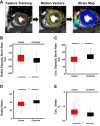Left ventricular diastolic dysfunction in women with nonobstructive ischemic heart disease: insights from magnetic resonance imaging and spectroscopy
- PMID: 28794105
- PMCID: PMC5668615
- DOI: 10.1152/ajpregu.00249.2017
Left ventricular diastolic dysfunction in women with nonobstructive ischemic heart disease: insights from magnetic resonance imaging and spectroscopy
Abstract
Ischemic heart disease, in the absence of obstructive coronary artery disease, is prevalent in women and constitutes a major risk factor for developing major adverse cardiovascular events, including myocardial infarction, stroke, and heart failure. For decades, diagnosis was considered benign and often minimized; however, it is now known that this etiology carries much risk and is a significant burden to the health care system. This review summarizes the current state of knowledge on nonobstructive ischemic heart disease (NOIHD), the association between NOIHD and left ventricular diastolic dysfunction, potential links between NOIHD and the development of heart failure with preserved ejection fraction (HFpEF), and therapeutic options and knowledge gaps for patients living with NOIHD.
Keywords: coronary microvascular disease; diastolic function; ischemic heart disease.
Copyright © 2017 the American Physiological Society.
Figures




Similar articles
-
Rationale and design of the women's ischemia syndrome evaluation mechanisms of coronary microvascular dysfunction leading to preheart failure with preserved ejection fraction (WISE Pre-HFPEF).Am Heart J. 2025 Jun;284:47-56. doi: 10.1016/j.ahj.2025.02.017. Epub 2025 Feb 24. Am Heart J. 2025. PMID: 40010584
-
Oxidative Stress Is Associated With Diastolic Dysfunction in Women With Ischemia With No Obstructive Coronary Artery Disease.J Am Heart Assoc. 2020 May 18;9(10):e015602. doi: 10.1161/JAHA.119.015602. Epub 2020 May 7. J Am Heart Assoc. 2020. PMID: 32375556 Free PMC article.
-
Cardiac magnetic resonance imaging in small animal models of human heart failure.Med Image Anal. 2003 Sep;7(3):369-75. doi: 10.1016/s1361-8415(03)00011-2. Med Image Anal. 2003. PMID: 12946475
-
Predicting benefit from revascularization in patients with ischemic heart failure: imaging of myocardial ischemia and viability.Circulation. 2011 Feb 1;123(4):444-50. doi: 10.1161/CIRCULATIONAHA.109.903369. Circulation. 2011. PMID: 21282521 Review. No abstract available.
-
Imaging and mechanisms of heart failure with preserved ejection fraction: a state-of-the-art review.Eur Heart J Cardiovasc Imaging. 2024 Oct 30;25(11):1475-1490. doi: 10.1093/ehjci/jeae152. Eur Heart J Cardiovasc Imaging. 2024. PMID: 38912836 Review.
Cited by
-
The 2019 New Investigator Review Awards.Am J Physiol Regul Integr Comp Physiol. 2019 Feb 1;316(2):R87. doi: 10.1152/ajpregu.00398.2018. Epub 2019 Jan 9. Am J Physiol Regul Integr Comp Physiol. 2019. PMID: 30624976 Free PMC article. No abstract available.
-
Late sodium channel blockade improves angina and myocardial perfusion in patients with severe coronary microvascular dysfunction: Women's Ischemia Syndrome Evaluation-Coronary Vascular Dysfunction ancillary study.Int J Cardiol. 2019 Feb 1;276:8-13. doi: 10.1016/j.ijcard.2018.09.081. Epub 2018 Sep 26. Int J Cardiol. 2019. PMID: 30293664 Free PMC article. Clinical Trial.
-
Impact of epicardial fat on coronary vascular function, cardiac morphology, and cardiac function in women with suspected INOCA.Eur Heart J Cardiovasc Imaging. 2024 Sep 30;25(10):1360-1366. doi: 10.1093/ehjci/jeae203. Eur Heart J Cardiovasc Imaging. 2024. PMID: 39129200 Free PMC article.
-
Left atrial stiffness in women with ischemia and no obstructive coronary artery disease: Novel insight from left atrial feature tracking.Clin Cardiol. 2020 Sep;43(9):986-992. doi: 10.1002/clc.23395. Epub 2020 May 27. Clin Cardiol. 2020. PMID: 32458454 Free PMC article.
-
Evaluation of left ventricular diastolic function in patients with coronary microvascular dysfunction via cardiovascular magnetic resonance feature tracking.Quant Imaging Med Surg. 2023 Oct 1;13(10):7281-7293. doi: 10.21037/qims-23-47. Epub 2023 Sep 11. Quant Imaging Med Surg. 2023. PMID: 37869269 Free PMC article.
References
-
- AlBadri A, Lai K, Wei J, Landes S, Mehta PK, Li Q, Johnson D, Reis SE, Kelsey SF, Bittner V, Sopko G, Shaw LJ, Pepine CJ, Bairey Merz CN. Inflammatory biomarkers as predictors of heart failure in women without obstructive coronary artery disease: A report from the NHLBI-sponsored Women’s Ischemia Syndrome Evaluation (WISE). PLoS One 12: e0177684, 2017. doi:10.1371/journal.pone.0177684. - DOI - PMC - PubMed
-
- Bairey Merz CN, Handberg EM, Shufelt CL, Mehta PK, Minissian MB, Wei J, Thomson LEJ, Berman DS, Shaw LJ, Petersen JW, Brown GH, Anderson RD, Shuster JJ, Cook-Wiens G, Rogatko A, Pepine CJ. A randomized, placebo-controlled trial of late Na current inhibition (ranolazine) in coronary microvascular dysfunction (CMD): impact on angina and myocardial perfusion reserve. Eur Heart J 37: 1504–1513, 2015. doi:10.1093/eurheartj/ehv647. - DOI - PMC - PubMed
-
- Bairey Merz CN, Shaw LJ, Reis SE, Bittner V, Kelsey SF, Olson M, Johnson BD, Pepine CJ, Mankad S, Sharaf BL, Rogers WJ, Pohost GM, Lerman A, Quyyumi AA, Sopko G; WISE Investigators . Insights from the NHLBI-Sponsored Women’s Ischemia Syndrome Evaluation (WISE) Study: Part II: gender differences in presentation, diagnosis, and outcome with regard to gender-based pathophysiology of atherosclerosis and macrovascular and microvascular coronary disease. J Am Coll Cardiol 47, Suppl: S21–S29, 2006. doi:10.1016/j.jacc.2004.12.084. - DOI - PubMed
-
- Bakir M, Nelson MD, Jones E, Li Q, Wei J, Sharif B, Minissian M, Shufelt C, Sopko G, Pepine CJ, Merz CNB. Heart failure hospitalization in women with signs and symptoms of ischemia: A report from the women’s ischemia syndrome evaluation study. Int J Cardiol 223: 936–939, 2016. doi:10.1016/j.ijcard.2016.07.301. - DOI - PMC - PubMed
-
- Bakir M, Wei J, Thomson L, Petersen J, Li Q, Jones E, Mehta PK, Shufelt C, Berman D, Handberg E, Kelsey S, Sopko G, Pepine C, Bairey Merz C. Prevalence of myocardial scar in women with signs and symptoms of ischemia but no obstructive coronary artery disease: a report from the Women's Ischemia Syndrome Evaluation (Abstract). American College of CardiologyAnnual Scientific Session and Expo San Diego, CA, March 14-16, 2015 2015, p. A1580.
Publication types
MeSH terms
LinkOut - more resources
Full Text Sources
Other Literature Sources
Medical

